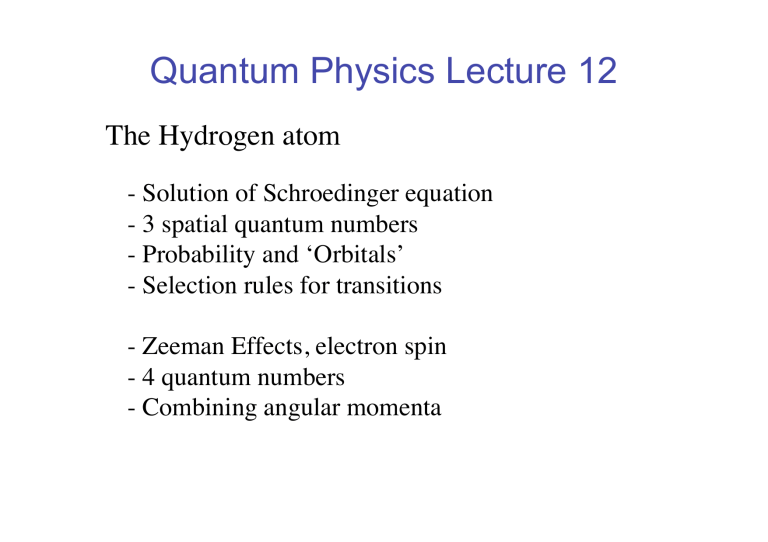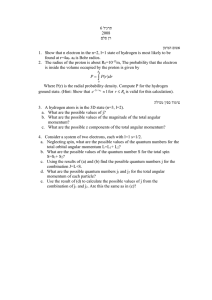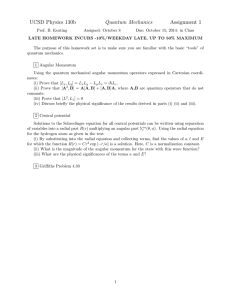And L

Quantum Physics Lecture 12
The Hydrogen atom
Solution of Schroedinger equation
3 spatial quantum numbers
Probability and ‘Orbitals’
Selection rules for transitions
Zeeman Effects, electron spin
4 quantum numbers
Combining angular momenta
Hydrogen Atom Re-visited
First real test of Schroedinger Equation:
Recall Bohr model: E n
∝
-1 /n 2 , via one quantum number n
(also, quantised angular momentum L via same n)
L
=
Successes: Hydrogen line emission spectra also… size & stability of atoms, Moseley’s Law for Z, etc. n
Problems: Full 3D & spherical symmetry?
Magnetic effects in spectra
Z > 1 atoms’ spectra
Comparison with Bohr model: same expression for E n
via “principal” quantum number n
Schroedinger Equation for H atom
Express wavefunction as product (c.f 2-D box)
Ψ
( r , θ , φ
)
= R r Θ θ Φ
( )
Leads to 3 separate equations
−
2
2 mr 2 d dr
⎛
⎝ r 2 dr
⎞
⎠
+
⎛
⎝
2
2 mr 2
+
( )
⎞
⎠
( )
= ER r
1 sin θ d d θ
⎛
⎝ sin θ d Θ d θ d 2 Φ
( ) d φ 2
⎞
⎠
+
⎛
⎝
( )
− m l
2 sin 2 θ
⎞
⎠
( )
= 0
+ m l
2 Φ
( )
= 0
R solutions are e α r
( × r polynomial) type, Θ are functions of cos & sin θ
Φ solutions are exp(im l ϕ
) type, where m l
is an integer
Solutions specified by three quantum numbers: n, l, m l
Schroedinger Equation for H atom (cont.)
Angular momentum - is quantised
Solution shows
L =
(c.f. angular momentum in lecture 11)
( )
Also Φ must be single valued and
Φ
( )
= Φ
(
φ + 2 π
)
Find
L z
= m l
( m l
= 0, ± 1, ± 2...
± l )
Note that L can be zero (unlike Bohr model)
And L z
< L (unless L=0)
∵
Exists an Uncertainty relation between L x
L y
L z
Bohr – plane, but must have Δ p normal to plane…
Also seen via
But ⎡⎣ L 2 , L z
⎤⎦
L x
L y
− L y
L x
= ⎡⎣ L x
, L y
⎤⎦ = i L z
(try it! – commutator)
= so no uncertainty between L and L z
& can know both
‘Semi-classical’ vector
pictures for l=2
Schroedinger Equation for H atom (cont.)
Solutions specified by three quantum numbers: n, l, m l
Energy Levels are E n
and the same as the Bohr model!
with n = 1, 2, 3, 4, ….
Solutions show l = 0, 1, 2, 3… n-1 and | m l
| ≤ l
Notation: s, p, d, f… for l = 0, 1, 2, 3, ….
So, possible states of electron:
( c.f. 3-D box, Lect. 9)
E n
= − me 4
8
ε 2 o h
2
Note: E n i.e. l, m
does not depend on l, m l l states are degenerate –
but holds only for H atom
Electron states in hydrogen atom - orbitals
( ) dr = ψ 2
4 π r 2 dr s -states - spherically symmetric
Radial probability distributions (a = Bohr radius)
Note for l = n-1 (1s, 2p, 3d…) there is one maximum, at r = n 2 a
Angular functions
- orbitals
The (m l
) sub-shells combine to give
spherically symmetric ( l ) shells - Spherical
‘harmonics’ (complete shells…) e.g. for 2p-states, cos θ & sin θ dependence
Squared (probability) & add - gives 1
Transition of electrons between orbitals
Selection rules for transitions:
Δ l = ± 1
And Δ m l
= 0 or ± 1
All others are ‘forbidden’
Conservation overall of angular momentum, photon has angular momentum of
l determines the magnitude of L , m l determines the direction
A non-zero magnetic field direction defines z
But B field alters the energy...
N.B. Magnetic dipole moment
(current in loop x area of loop) e+ e-
µ = ve
2 π r
π r 2 with mvr
= µ
B
= e
2
m
(Bohr Magneton)
So moment = m l
µ
B
Applied B field shifts energy (dipole-field interaction) so m l states are split apart by µ
B
B
Zeeman Effect
In non-zero magnetic field B each l -level splits into 2 l +1
m l
sub-levels of slightly
different energy, depending
on B
Spectra show three lines
instead of one; only three
because of further selection
rule:
Δ m l
= ± 1, 0
But…. some transitions
showed more than three -
anomalous
Anomalous Zeeman Effect
Problem: more than 3 lines and smaller separation(s)
Solution:
“electron spin”
See lecture 11 !
Electron has spin angular momentum s z
= ±
but
2
Spin angular momentum S (cf L) Spin magnetic quantum number m s
(cf m l
)
µ z
= −
(
2.000232
) e
2 m s z
Total combined angular momentum J
J
=
+ S
J =
( )
j = l ±
1
2
Combining L and S leads to correct number and splitting of emission lines
(first seen by Irishman Thomas Preston)





